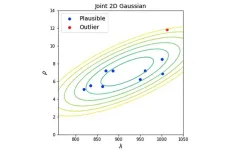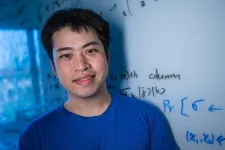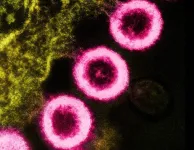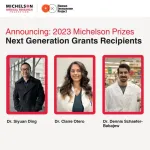(Press-News.org) EMBARGOED FOR RELEASE UNTIL 4 P.M. ET, TUESDAY, MARCH 5, 2024
MINNEAPOLIS – People who have headaches after experiencing concussions may also be more likely to have higher levels of iron in areas of the brain, which is a sign of injury to brain cells, according to a preliminary study released today, March 5, 2024, that will be presented at the American Academy of Neurology’s 76th Annual Meeting taking place April 13–18, 2024, in person in Denver and online.
“These results suggest that iron accumulation in the brain can be used as a biomarker for concussion and post-traumatic headache, which could potentially help us understand the underlying processes that occur with these conditions,” said study author Simona Nikolova, PhD, of the Mayo Clinic in Phoenix, Arizona, and a member of the American Academy of Neurology.
The study involved 60 people who had post-traumatic headache due to mild traumatic brain injury, or concussion. The injuries were due to a fall for 45% of the people, 30% were due to a motor vehicle accident and 12% were due to a fight. Other causes were the head hitting against or by an object and sports injuries. A total of 46% of the people had one mild traumatic brain injury in their lifetime, 17% had two, 16% had three, 5% had four and 16% had five or more mild traumatic brain injuries.
The people with mild traumatic brain injuries were matched with 60 people who had not had concussions or post-traumatic headache.
All the participants had brain scans to look at iron levels in various areas of the brain, using an indirect measure for iron burden. For those with mild traumatic brain injuries, the scans were taken an average of 25 days after the injury.
The study found that compared to the people without concussion, those with a history of concussion and headaches had higher levels of iron accumulation in several areas of the brain, including the left occipital area, right cerebellum and right temporal lobe. For example, in the left occipital area, those with concussion and headaches had more iron accumulation than those with no concussion or headaches.
Researchers also found that the more concussions people had over their lifetime and the more frequent their headaches were, the more likely they were to have higher levels of iron accumulation in certain areas of the brain. They also found that the more time that had passed since the concussion occurred, the more likely people were to have higher levels of iron accumulation in areas of the brain.
“Previous studies have shown that iron accumulation can affect how areas of the brain interact with each other,” Nikolova said. “This research may help us better understand how the brain responds and recovers from concussion.”
Nikolova said that since the study used an indirect measure of iron burden, it’s possible that the change in that measure could be due to other factors such as hemorrhage or changes in tissue water rather than iron accumulation.
The study was supported by the U.S. Department of Defense and the National Institutes of Health.
Learn more about concussion at BrainandLife.org, home of the American Academy of Neurology’s free patient and caregiver magazine focused on the intersection of neurologic disease and brain health. Follow Brain & Life® on Facebook, X and Instagram.
When posting to social media channels about this research, we encourage you to use the American Academy of Neurology’s Annual Meeting hashtag #AANAM.
The American Academy of Neurology is the world’s largest association of neurologists and neuroscience professionals, with over 40,000 members. The AAN is dedicated to promoting the highest quality patient-centered neurologic care. A neurologist is a doctor with specialized training in diagnosing, treating and managing disorders of the brain and nervous system such as Alzheimer’s disease, stroke, migraine, multiple sclerosis, concussion, Parkinson’s disease and epilepsy.
For more information about the American Academy of Neurology, visit AAN.com or find us on Facebook, X, Instagram, LinkedIn and YouTube.
END
Does iron accumulate in brain after concussions?
2024-03-05
ELSE PRESS RELEASES FROM THIS DATE:
Salk Professor Terrence Sejnowski wins Brain Prize
2024-03-05
LA JOLLA—(March 5, 2024) Salk Institute Professor Terrence Sejnowski will receive the 2024 Brain Prize for “pioneering the field of computational and theoretical neuroscience, making seminal contributions to our understanding of the brain, and paving the way for the development of brain-inspired artificial intelligence,” the Lundbeck Foundation announced today.
Sejnowski shares the prize—the world’s top recognition in neuroscience, totaling 10 million DKK (approximately $1.5 million)—with Larry Abbott of Columbia University and Haim Sompolinsky of Harvard University and Hebrew ...
A call for standardization of controls in lifespan studies
2024-03-05
“[...] we posit that the majority of results in biology of aging may be irrelevant to the fundamental aim of this field and must be acknowledged appropriately.”
BUFFALO, NY- March 5, 2024 – A new research perspective was published in Aging (listed by MEDLINE/PubMed as "Aging (Albany NY)" and "Aging-US" by Web of Science) Volume 16, Issue 4, entitled, “On standardization of controls in lifespan studies.”
In this new paper, researchers Olga Spiridonova, Dmitrii Kriukov, Nikolai Nemirovich-Danchenko, and Leonid Peshkin from Harvard Medical ...
How bias shows up in maps made with citizen science data
2024-03-05
When biologist Elizabeth Carlen pulled up in her 2007 Subaru for her first look around St. Louis, she was already checking for the squirrels. Arriving as a newcomer from New York City, Carlen had scrolled through maps and lists of recent sightings in a digital application called iNaturalist. This app is a popular tool for reporting and sharing sightings of animals and plants.
People often start using apps like iNaturalist and eBird when they get interested in a contributory science project (also sometimes called a citizen science project). Armed with cellphones equipped with cameras and GPS, app-wielding volunteers can submit geolocated data that iNaturalist then translates into user-friendly ...
Rice’s Nai-Hui Chia wins NSF CAREER Award
2024-03-05
HOUSTON – (March 5, 2024) – Nai-Hui Chia, an assistant professor of computer science at Rice University, has won a National Science Foundation CAREER Award to develop a new theoretical framework to facilitate the development of efficient quantum algorithms for a range of problems in quantum physics and computer science as well as enhance the security of quantum cryptography.
The highly competitive grants are awarded each year to a selective cohort of about 500 early career faculty across all disciplines engaged in pathbreaking research and committed to growing their field through outreach and education.
“Quantum computing holds immense ...
Vaginal ring and oral pre-exposure prophylaxis found safe for HIV prevention throughout pregnancy
2024-03-05
WHAT:
The monthly dapivirine vaginal ring and daily oral pre-exposure prophylaxis (PrEP) with tenofovir disoproxil fumarate and emtricitabine were each found to be safe for HIV prevention among cisgender women who started using one of them in their second trimester of pregnancy, according to findings presented today at the 2024 Conference on Retroviruses and Opportunistic Infections (CROI) in Denver. Pregnant people are estimated to be three times more likely to acquire HIV through sexual intercourse than similarly aged people who ...
Michelson Medical Research Foundation and Human Immunome Project announce 2023 Michelson Prize Laureates
2024-03-05
Michelson Medical Research Foundation (MMRF) and Human Immunome Project (HIP) have awarded Dr. Siyuan Ding (Washington University in St. Louis), Dr. Claire Otero (Weill Cornell Medicine), and Dr. Dennis Schaefer-Babajew (Rockefeller University) the Michelson Prizes: Next Generation Grants, the organizations announced today.
The $150,000 research grants are awarded annually to support early-career scientists advancing human immunology, vaccine discovery, and immunotherapy research for major global ...
New method measures the 3D position of individual atoms
2024-03-05
Since more than a decade it has been possible for physicists to accurately measure the location of individual atoms to a precision of smaller than one thousandth of a millimeter using a special type of microscope. However, this method has so far only provided the x and y coordinates. Information on the vertical position of the atom – i.e., the distance between the atom and the microscope objective – is lacking. A new method has now been developed that can determine all three spatial coordinates of an atom with one single image. This method – developed by the University of Bonn and University of Bristol ...
Cleveland Clinic-led research supports repurposing sildenafil (Viagra) for Alzheimer’s treatment
2024-03-05
CLEVELAND – New Cleveland Clinic-led research points to sildenafil (Viagra) as a potential treatment for Alzheimer’s disease. The study provides evidence from computational models, insurance claims data and observations from brain cells in Alzheimer’s patients.
Sildenafil is the main component of drugs used to treat erectile dysfunction (Viagra) and pulmonary arterial hypertension (Revatio).
“Our findings provide further weight to re-purposing this existing FDA-approved drug as a novel treatment for Alzheimer’s, which is in great need of new therapies,” ...
Antarctic researchers hitched a lift on a cruise ship, and recommend this eco-friendly, collaborative approach to remote ocean science
2024-03-05
Antarctic researchers hitched a lift on a cruise ship, and recommend this eco-friendly, collaborative approach to remote ocean science.
####
Article URL: https://journals.plos.org/climate/article?id=10.1371/journal.pclm.0000348
Article Title: New methods of undertaking marine science in Antarctica using tourism vessels
Contact: Matthew Mulrennan; matt@kolossal.org
Author Countries: Canada, United States
Funding: The authors received no specific funding for this work. END ...
Odysseus has a new home and brings the Earthling Project along for the ride
2024-03-05
March 5, 2024, Mountain View, CA – The moon lander Odysseus, known as Odie, touched down on the Moon's surface on February 22, becoming the first time the U.S. has landed on the Moon in more than 50 years and the first commercial moon lander to successfully land on the Moon. Along with its science payload, the spacecraft also brought along a fusion of art and space exploration, SETI Institute's Artist in Residence (SETI AIR), Felipe Pérez Santiago's Earthling Project, a collection of global musical compositions representing Earth's cultural ...








